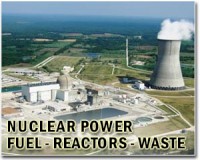 |
Tokyo (AFP) March 12, 2011 Japan said on Saturday that an ageing nuclear plant may be in meltdown after a huge quake and monster tsunami ravaged a large area of the northeast, leaving more than 1,000 people feared dead. Japan, which has experienced the only two deadly nuclear accidents since Chernobyl, faces atomic crisis after the cooling systems failed in reactors at two plants, forcing the evacuation of tens of thousands of homes. Following is a list of the world's worst nuclear accidents in the past quarter of a century: - March 28, 1979: 140,000 people are evacuated after an accident at Three Mile Island in Pennsylvania, United States. The reactor's core suffers partial meltdown, causing contamination within the plant but none outside. There are no casualties. The accident registers five on the International Atomic Energy Agency's seven-point scale of nuclear accidents. - August 1979: A leak of uranium at a secret nuclear site near Erwin in Tennessee, United States, contaminates some 1,000 people. - January-March 1981: Four radioactive leaks occur in succession at the Tsuruga nuclear plant in Japan. According to official figures, 278 people are contaminated. - April 26, 1986: The world's worst nuclear incident occurs when Reactor Number Four at Ukraine's Chernobyl plant blows up after an experiment goes wrong and the top of the reactor blows off. Some 200 people are seriously contaminated, of whom 32 die within three months. The accident is only revealed after a giant radioactive cloud is registered moving across northern Europe. The fall-out is recorded as being equivalent to that from more than 200 atomic bombs of the type dropped by the US on Hiroshima in 1945. Hundreds of thousands of residents are evacuated from the area and a similar number are estimated to have been contaminated by radiation. The incident registers the maximum seven on the international scale. - April 1993: An explosion at a secret reprocessing plant in Tomsk-7 in western Siberia releases a cloud of radioactive gas, including Uranium-235, Plutonium-237 and various other fissile materials. The number of casualties is unclear. - November 1995: Serious contamination is reported at Chernobyl during the removal of fuel from one of the plant's reactors. The incident is reported only after an apparent attempt to cover it up. - March 11, 1997: Work at the experimental treatment plant in Tokaimura, northeast of Tokyo, is partially halted after a fire and an explosion expose 37 people to radiation. - September 30, 1999: Two workers die in an accident at the uranium processing plant in Tokaimura, Japan -- the world's worst since Chernobyl, rating four on the seven-point scale. Workers at the plant pour too much uranium into a precipitation tank as they cut corners to save time and can only watch helplessly as a blue flash signals the start of Japan's most serious nuclear accident. It exposes more than 600 people to radiation and forces around 320,000 to shelter indoors for more than a day. Two of the workers who triggered the disaster die from their injuries in hospital, three and six months after the incident. The first had been exposed to 17,000 times the average annual dose of radiation. - August 9, 2004: Four workers are killed and seven others severely burned by a leak of non-radioactive steam at a nuclear plant in Mihama, 350 kilometres (220 miles) west of Tokyo. One of the three nuclear reactors at the plant shuts down automatically when an alarm sounds just before super-heated steam leaks from a turbine and scalds workers. It is Japan's worst accident at a nuclear facility in terms of the number of deaths.
Share This Article With Planet Earth
Related Links Nuclear Power News - Nuclear Science, Nuclear Technology Powering The World in the 21st Century at Energy-Daily.com
 High radiation in Japan nuclear plant, 'no health hazard'
High radiation in Japan nuclear plant, 'no health hazard'Tokyo (AFP) March 12, 2011 A Japanese nuclear safety panel said Saturday radiation levels were 1,000 times above normal in a reactor control room after a huge quake damaged a plant's cooling system, Kyodo News said. Public broadcaster NHK, quoting nuclear safety officials, said there was "no immediate health hazard" to nearby residents from a possible minute leakage, and people were urged to evacuate the area calmly. ... read more |
|
| The content herein, unless otherwise known to be public domain, are Copyright 1995-2010 - SpaceDaily. AFP and UPI Wire Stories are copyright Agence France-Presse and United Press International. ESA Portal Reports are copyright European Space Agency. All NASA sourced material is public domain. Additional copyrights may apply in whole or part to other bona fide parties. Advertising does not imply endorsement,agreement or approval of any opinions, statements or information provided by SpaceDaily on any Web page published or hosted by SpaceDaily. Privacy Statement |